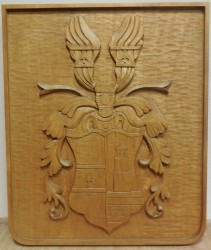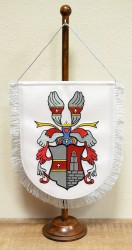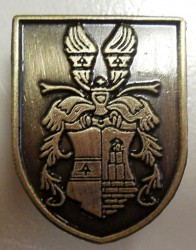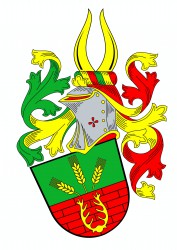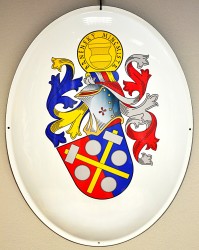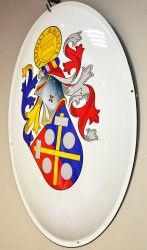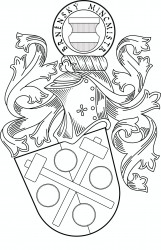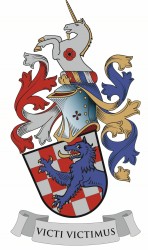The designing of a personal and a family coat of arms
A personal coat of arms is a magnificent gift for a jubilee, also, making a family coat of arms may start a wonderful family tradition connected with handing over values, ideas and the proverbial family reins. Personal coats of arms are designed according to the conventions of citizen heraldry. We can create a personal or family coat of arms, or full heraldic achievement tailored to your desires.
Our company belongs to the leading Czech heraldic companies. The creation of a personal coat of arms or heraldic achievement by our heraldic office is a complete service, including initial information finding and historical research, subsequent visual design and final rendition. The first step in getting an entirely new personal coat of arms is filling in a form, the next step is a consultation with one of our sales representatives and our heraldist.
What is usually depicted in a coat of arms?
It is not an easy task to devise and design an appropriate symbol (a figure or figures). It should meet the strict heraldic conventions, personal and historical context, family tradition, profession, values, personal ideas and wishes of its bearer. These attributes are very important and the rendition of them into their visual form should be done in simple heraldic symbolic form. With the help of our leading heraldist, we are able to ensure expert services in creation of coats or arms and heraldic achievements. The resulting symbols will be a fitting representation capturing your uniqueness.
The essence of a family coat of arms
A personal or a family coat of arms is based on the historical composition of a coat of arms of nobility or bourgeoisie. It consists of a shield (escutcheon), helmet, mantling, torse, crest, and in some cases even a slogan (battle cry). The coat of arms should be visually simple and without divisions of the field. The first step in getting an entirely new personal coat of arms is filling in a form, the next step is a consultation with one of our sales representatives and our heraldist.
Where can the coat of arms be used?
Even today, a coat of arms may serve you in multiple ways, at the same time it is a very personal and original representation and it can tell a lot about its owner. It can be used on cards, invitations, in your e-mail signature, on headed paper, or on a rubber stamp or handstamp, used under your own signature on various documents, including seals. And of course, you can have your coat of arms transformed into a tangible form, the form of a ceremonial hand-embroidered banner of arms. The banner can then show the shield itself by spreading it in the field of a flag. Other options can be a wood carved coat of arms, a die-cast product, or an enamel sign.
Additional services for the production of a personal coat of arms and achievement
Besides the creation of a completely original coat of arms, we also offer gaining of a copyright license to use the symbol in the sense of the Copyright Act, we also offer the formulation of expert heraldic description of the coat of arms (so-called blazon), and a report containing historical background, reasoning behind the symbols’ rendition, descriptions of the figures and their meanings. Your personal or family coat of arms will be added into the register of personal and family coats of arms, and with your permission, we will openly publish it. We can also add your symbol in other highly regarded registries, such as The Czech Genealogy and Heraldry Society in Prague (ČGHSP).
Examples of personal coats of arms made by our company
- Personal heraldic achievement of Mr. Jan Dvořák
- Personal heraldic achievement of Mgr. Milada Prokopová
- Personal heraldic achievement of JUDr. Vlastimil Vlk
Heraldic conventions observed during the creation of a personal coat of arms
In the Czech Republic, the use and making of so-called personal coats of arms is not legally established, as it is for example in Great Britain, or even in Slovakia, and the tradition is not as strong as for example in Switzerland. However, it is based on historical and generally applicable heraldic conventions and principles, commonly used in burgher context since the early modern period. Personal heraldry also cannot be equated with the aristocratic (nobility) heraldry, and for that reason a term full “civilian coat of arms” would be more appropriate than “heraldic achievement” (in Czech “šlechtický rodový erb”). The Czech word “erb” comes from the German "der Erbe = heir, heirloom". The foundation of every heraldic achievement (or armorial achievement) is always the shield (escutcheon), which could have been used on its own, for example by women who usually did not carry armor, and also in citizen heraldry where this rule is binding. The so-called full heraldic achievement, representing the physical being of its bearer, consists of an escutcheon, a helm with torse, mantling and crest. Strict policy applies for the citizenry to use only a so-called tilting helm, originating in15th century, either with or without a torse, but never with a crown! The escutcheon can under no circumstances be complex, for example divided by cross and so on. So-called supporters are also not acceptable, simplicity and overall distinctiveness of the entire composition of a coat of arms is preferred. According to the wishes and characteristics of its user, a personal coat of arms will consist of appropriate figures (these figures are either so-called ordinaries, or charges) in appropriate heraldic tinctures. There are six tinctures, two metals, argent and or (silver and gold, usually rendered as white and yellow) and four colors (red - gules, blue - azure, green - vert, and black - sable), in some cases a natural color can be used (for example for the tree trunks, skin color, etc.). A basic rule applies that a metal is placed on a color, and a color on a metal! The shield in a coat of arms is always blazoned, i.e. expertly described, from the shield bearer’s perspective (his right arm), never from the observer’s perspective. Vertical or inclined position of the shield is associated with the drawing of the coat of arms in profile or en face. The tilting helm has an ordinary steel grey color, with golden fittings and red lining. The cloth of the mantling of the helm bear tinctures of the shield so that the color (or colors) are always in the upper position and the metal is in the lower position (as a lining). The tinctures of the mantling can be the same on both sides or variably combined. The torse must be alternately colored with a metal (metals) and color (colors) used in the shield. Can we stick to the British custom that the first visible thread of a torse must be a metal, but that is not an obligation. It is also possible, in exceptional and justifiable cases, to omit the torse (a fabric wreath) altogether, then the crest is placed directly on the helm. Or, we can replace the torse with another figure, for example a cushion, etc. The crest on the helm, and the torse, is usually a prominent figure appearing in the shield, or other selected charge. There is also a possibility to use one of the oldest and most common types of crests (i.e. wings, horns, peacock or ostrich feathers), again, proper shield tinctures must be used, additionally, the crest can be added with a specific (initially chosen) figure.



